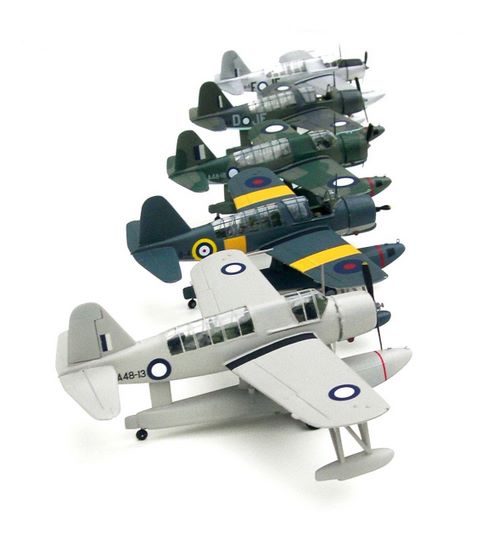by Raul Hrubisko
Click here for the first part of this article
In the first part of this review of my collection of American aircraft in FAA service, we have covered the early war period, marked by a number of unsuccessful pre-Lend-Lease acquisitions and the first truly great American aircraft in the FAA service, the Grumman Martlet (Wildcat). Next in line according to the same chronology, are the sole Curtiss Seamew, Vought Kingfisher and the Grumman Hellcat.
Curtiss Seamew
Originally named in the Seagull, in British nomenclature the Curtiss SOC was called Seamew. Plans were made in January 1943 for the No. 803 Squadron FAA to operate this aircraft from escort aircraft carriers, but testing in A&AEE raised serious doubts about its suitability for operational use. Therefore the Seamew was confined to training role with the 755 squadron.
The model was a comparatively easy out-of-the-box build from the Special Hobby kit.
Vought Kingfisher
As a potential replacement for the venerable Supermarine Walrus and the little-used Fairey Seafox, the OS2U Kingfisher arrived in Britain in May 1942 as Kingfisher Mk. I. The landplane version was tested in A&AEE and the floatplane in the MAEE with good results. Therefore the aircraft obtained the approval to operate onboard armed merchant cruisers. Thus the Kingfisher became the first catapult-launched monoplane in the FAA. It served in this role until May 1944 when all remaining aircraft were withdrawn from the Fleet Air Arm service.
The RAAF received their Kingfishers in two batches (A48-01 to 18). The first batch went to Rathmines and the another to Point Cook, Victoria. The Kingfisher still flew in Australia for many years after the end of Word War II.
I couldn’t obtain the new Kingfisher kit from Pavla so I bought as many Airfix kits as I could locate. Fortunately, the Airfix Kingfisher was re-issued in the 1990’s. The kit is quite good but I improved it by making a new cowling, adding a Pratt & Whitney R 985 SB3 engine from Beech Traveller kit and adding minor details like the ties. I made both versions of the aircraft, the floatplane and the landplane. One of the Landplane aircraft that I built was tested in A&AEE and the other was used as a trainer in the RAAF.
The most complicated part of this project was covering all the various colour schemes used on RAAF Kingfishers. I arrived at four different variants, and thus run out of my Airfix kits. Cloning 3 additional copies in resin solved the problem.
When building models in large series like I do, availability of certain kits in sufficient quantity becomes a problem. To overcome this, I started to clone (duplicate) entire kits in resin. In time, this process has become a routine and the assembly of the copied item is no more difficult than that if the original. The canopies, however, need to be heat-formed from sheet acetate.
Grumman Hellcat (Gauntlet)
Grumman F6F Hellcat was the second of the great naval fighter trio which made success both in US Navy and the FAA. Deliveries of the F6F-3 to Britain began in March 1943. The original suggested name was Gannet, but it had been abandoned in favour of Hellcat Mk I.
I built all the versions of this aircraft including: Hellcat Mk I, Mk II, FR. Mk II, PR Mk II, NF Mk II. I also made some aircraft which were involved in rocket and bomb trials at A&AEE.
Kits of the Hellcat are no problem, and I used a mixture of them: Academy, some Hasegawa and one Italeri for the NF Mk II. I modified the side of the fuselage on the FR version aircraft in order to make the camera window.
One aircraft in this series is special to me. Hellcat JZ796 C-7X nicknamed Patoruzu which was flown by an Argentine pilot Sub-Lieutenant Oscar Lorenzo, No. 808 Squadron FAA in Trincomalee, Ceylon. It had an honour of receiving a personally signed photo of his aircraft. A friend of mine made the corresponding decals.
To be continued…
This article was originally published in IPMS Stockholms Magazine in October 2007






















































